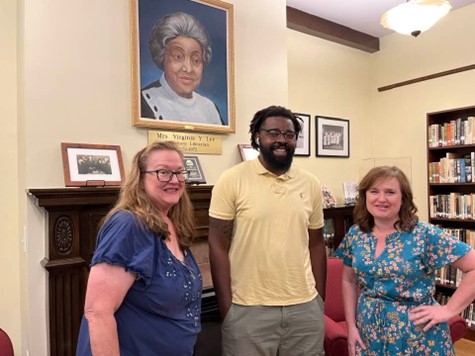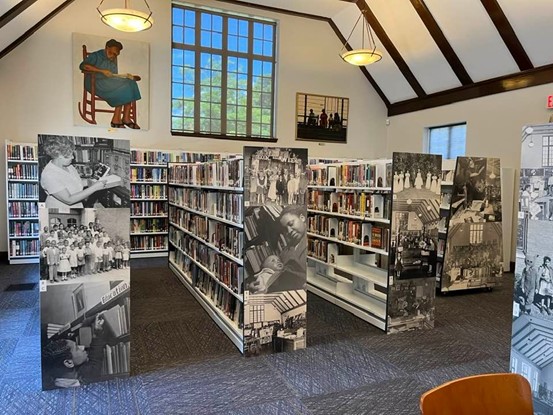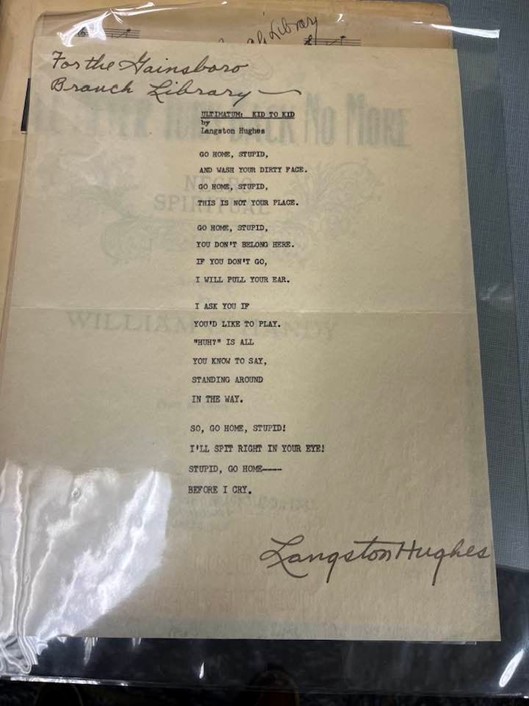The Gainsboro Public Library is a branch of the Roanoke Valley Libraries (RVL). It does not have a website of its own. All branches of the RVL utilize the same website (https://www.roanokeva.gov/892/Libraries), which is part of the City of Roanoke website. The website is generic, but easy to navigate. Specific locations and times of operations may be found on the RVL website. The RVL is made up of 19 branch libraries in Roanoke City, Roanoke County, the City of Salem, and Botetourt County. Branches are conveniently located within different neighborhoods; most are near schools. The Gainsboro Library serves a mostly Black community in northwest Roanoke, as well as many patrons who work in the downtown Roanoke area and those who live in the adjacent retirement community.
In addition to providing a listing of branch locations, the website currently contains information about the Summer Reading Program, Star City Reads, a local eBranch library, library events and programming, interlibrary loans, publicly available internet resources, the Law Library, the Virginia Room, and a talking book service for those who are visually impaired. Staff members names are not found on the website. Special services listed on the website are not specific to any branch library, but include services for those who are visually impaired, interpreter services for those who do not speak English, Libby (digital library service providing ebooks and e-audiobooks), Tumblebooks (digital library for children that provides read-a-loud books), Find It Virginia (a group of curated websites and databases), and Universal Class (a resource containing over 500 continuing education courses). Finally, the website contains access to the library catalog. When a title is requested, a list of all copies and their locations appears in a pop-up window. Next to each location, the status of the item is listed and a link to reserve the item is available if so desired.
When I arrived at the Gainsboro Library and parked on the curb in the front, I saw a quaint older Tudor-style building with a Virginia Historic Landmark sign hanging on the front next to a sign listing the library hours. There is a bicycle rack off to the side of the building. A public bus stop is located at a nearby street corner. The library is located adjacent to a retirement community, a Catholic church, and a Catholic school. The priest at the Catholic church played a huge role in obtaining the land for the library by petitioning Pope Pius XII for usage (M. Mizak, personal communication, July 14, 2022). The Pope provided the library with usage of the land for 99 years. There is a tiny free library at the front of the library where patrons may take or leave books for anyone to take with them. An overnight book return is located next to the tiny library. The door is accessed by handicap ramps from both sides of the door down to the sidewalk. Buttons on both sides of the door open the heavy wooden door automatically.
The library is staffed by one full-time Librarian, one full-time Associate Librarian 1, one full-time Associate Librarian 2, and two part-time Teen Librarian Apprentices. The three full-time librarians rotate so that there are always two librarians working for safety purposes. The Librarian manages the branch and is the curator of the Virginia Y. Lee collection. She also works with special programs. The Associate Librarian 1 is responsible for reshelving and weeding the books, tending the Lee collection, and the feeding program. The Associate Librarian 2 remains at the desk most of the time assisting patrons with checking out items, troubleshooting computer issues, and assisting with children’s programs. The two Teen Librarian Apprentices run the summer programs and after-school programs for the teens.

Upon entering the door, I entered the main part of the library. The library is small, with a children’s section to the right and the adult section to the left. The adult side of the library also contains a section of DVDs and audiobooks. The shelves are tall and may be difficult to access by someone in a wheelchair. The librarians greeted almost every patron by name and were very helpful, so I am certain they would assist anyone in need of access. On either side of the door, computer tables hold a total of 10 computers. There are another 3 computers in front of the children’s section on lower tables. The colors are bright and vibrant, reflecting the modern vibe intended by the recent renovation. Furniture is comfortable and functional. The ceilings are high and make the space feel larger than it really is and bright. The circulation desk is located about 20 feet in front of the door. A display of newly released books is located to the left of the circulation desk. The librarians have an office behind the desk.
Beyond the children’s side of the library is a hallway that extends to the rear of the building. The Teen Room is the first room on the right off the of hallway. It is a brightly colored room containing very modern furniture in bright primary colors. Higher tables and stools on two walls provide space for 10 computers. The room contains a collection of young adult books and graphic novels. On this day, the Teen Room was a hub of activity. Across from the Teen Room is a group study room that is utilized frequently by an alterative education school for small groups of students and the restrooms, which are handicapped accessible.
At the end of the hall is a large community room. The list of events on the wall indicated that the room is used quite frequently. The art on the walls reflected the history of the community. The combination of rooms and activities promoted at this branch library exemplify the five civic leadership roles for public libraries identified by the Urban Libraries Council in Rubin and Rubin (2020), namely: civic educator, conversation starter, community bridge, visionary, and civic forum (p. 117). The Gainsboro Library acts as a community hub for engagement, a meeting house, a safe place to hang out, and a space to meet basic needs. The librarians seek to make connections with everyone who enters the doors.

Due to the historic nature of the Gainsboro Library, one of the most noticeable features of the renovation is the reproduction of pictures of the library on the ends of the stacks on the adult side of the library. The photos depict pictures of patrons using the library and what the library looked like when the branch was built in the early 1940s as seen in Figure 2. To the rear of the adult side of the library, a hall leads to a group study room on the right and the Virginia Y. Lee Special Collection Room at the end of the hall. The Virginia Y. Lee Special Collection contains items curated by the librarian who spearheaded the building of the branch and other items of Black historical significance obtained more recently. In the early 1900s, the main way Black librarians obtained media was writing letters to Black authors, poets, musicians, and other artists and requesting materials (M. Mizak, personal communication, July 14, 2022). Many of the items in the special collection, including books, poems, and sheet music, are signed by the author. One of the most entertaining was a poem, Ultimatum: Kid to Kid, that was hand typed and signed by Langston Hughes.

The Gainsboro Library is very small but accommodating. If they do not have an item in their stacks, they will request it through interlibrary loan. Many computers are in use constantly. Rubin and Rubin (2020) note that the “digital divide” is persistent within communities of low socioeconomic status (p. 123). The Gainsboro Library provides services to fill that gap for many patrons. The library catalog is accessible on every computer. If a patron does not have a library card, one of the librarians will assist them with logging on to the computer. The library is organized by the Dewey decimal system, and everything was marked and easy to find. Based on the number of patrons in the library, diversity, and span of ages from infants to geriatrics, it was clear that everyone feels welcome at the Gainsboro Library. At the time of my visit, a group of 12 teens were having a lesson on the computers in the Teen Room, a group of alumni from a former Black high school were meeting, people were coming in to pick up food (the library is a Feeding America site), several people were using computers and printing items, and several people were browsing the stacks and checking out books and DVDs.
The Librarian, Megan Mizak, has been curator of the archives at the Gainsboro Library for several years and assists with local Black history research. She is also a miniaturist and is creating a miniature library. Ms. Mizak has obtained two small recorders for oral histories and a small hand-held scanner for the library, all of which are available to check out to history buffs. She has proactively requested items of interest related to local Black families, buildings, and culture. Her small office contains file cabinets and Hollinger boxes of materials labeled by family, building, or other items of historic interest. She shared the original information flyer regarding the bond referendum to pay for the building (M. Mizak, personal communication, July 14, 2022). The story behind the referendum was very telling of the time. City Councilmen did not want to put the library building in the bond which was also going to be used to pay for what would become the Main Branch Library, Elmwood Park, Victory Stadium, an athletic field, and an armory. Leaders in the Black community insisted that the Gainsboro Library be included in the referendum, or the entire Black community would vote against the referendum, and it would likely not pass.
What the Gainsboro Library lacks in size, it makes up in heart. I was very surprised to see all of the artifacts related to local Black history contained in the small space. The pride the librarian took in her collection was evident and her willingness to share stories and show me around the library went above and beyond anything I was expecting. I would guess that this is a very unique branch library, but it makes me wonder what hidden gems I may be able to find at other small libraries.
References
City of Roanoke. (n.d.). Libraries. https://www.roanokeva.gov/892/Libraries
Rubin, R. E., & Rubin, R. G. (2020). Foundations of library and information science (5th ed.). ALA Neal-Schuman.
Julie,
I loved reading about this library and the history it holds! I especially loved learning about the Virginia Lee special collection and the history behind it. What amazing artifacts to have, not many places have anything like that. Did you choose to visit this library because of its history? Is it a busy branch in Roanoke? I loved your ending sentiments about it how much heart this library has, and about the pride the librarians take in their collections. Thanks for sharing!
Maria,
Thanks for your kind words. I chose to visit this library because it is the branch I generally go to and Megan, the lead librarian, had recently shared a brochure about a website she and a few others had published about the history of the Gainsboro community. If you have a chance to read Truevine, by Beth Macy (who also wrote Dopesick), you can learn a little about the area. For its size, the branch is very busy. The librarians are always looking for more ways to serve the community.
I really enjoyed reading about your library visit. You write so well that I felt like I was walking through the library with you. Langston Hughes is one of my favorite poets, so I was absolutely loving that they had a signed poem by him at the library. I also enjoyed hearing how much the librarian enjoyed showing you around and talking about it all that makes me feel like she loves what she does. The pictures displayed are beautiful. What a gem found in Roanoke!